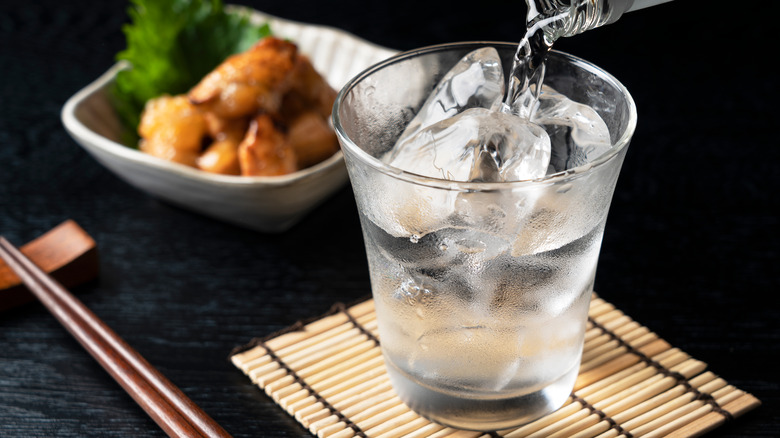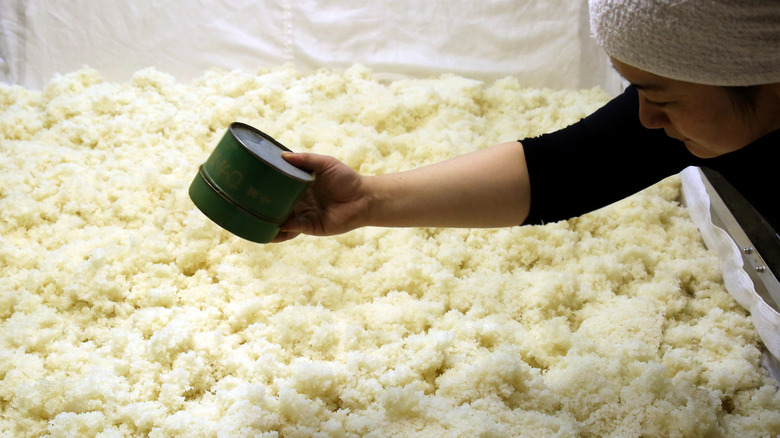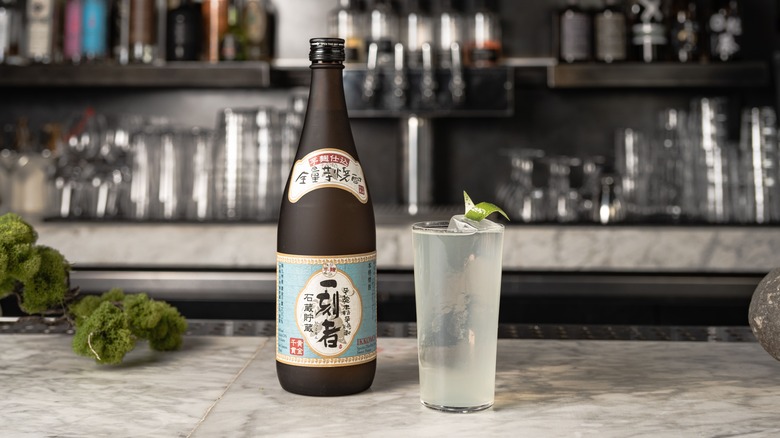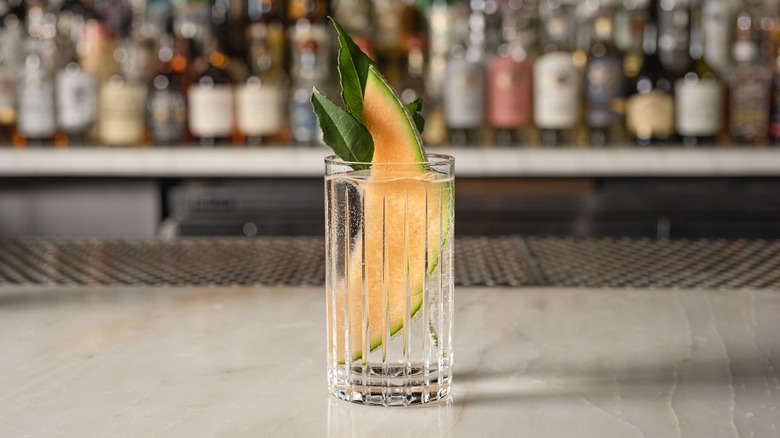What Makes Shochu Unique?
Shochu is to Japan as vodka is to Russia — any Japanese restaurant that serves alcohol will likely have some offering of shochu on its menu. This clear spirit, with a relatively low ABV of 20% to 30%, is the alcoholic beverage of choice in Japan, yet the rest of the world has somehow overlooked it (per Liquor). Shochu is an effervescent, light, yet complex alcohol with a depth of flavor and a dangerously smooth finish. Shochu is sugar and carb-free, which makes it slightly healthier than other alcoholic beverages, according to The Japanese Bar.
In a way, shochu is the perfect spirit for anyone who dislikes the sting of alcohol on their throat. And it's especially good if you cannot stand the sickly sweet syrups in many cocktails that attempt to mask the alcohol. Shochu is smooth and light, and only slightly fragrant, enough to make it truly enjoyable on its own. "It's a low ABV spirit, but it still has a lot of depth, so instead of trying it as a substitute for something you're used to, shochu opens up a whole new category for cocktails," says mixologist Sam Walton of kodō LA.
How shochu is made
Japanese shochu is a distilled spirit made from koji and other raw ingredients. According to Masterclass, koji is a type of Aspergillus oryzae which is a Japanese fungus used for all sorts of foods, including sake, rice wine, and miso. Like yeast additives in baking or fermenting, koji is a catalyst for the shochu fermentation process. Whether added to steamed rice or steamed sweet potatoes, koji grows mold onto the base ingredient, turning the whole mixture acidic. Once koji makes the environment acidic, the starches are transformed into sugars, which are turned into ethanol from the yeast (via The Japan Food Product Overseas Promotion Center, JFOODO).
Satsuma Shuzo states that shochu can be made through a single-distillation process or a multiple-distillation process. Single-distillation shochu yields a stronger flavor, with more of the natural aromas and ingredients of the base materials present in the drink. A multiple-distillation process, which is how vodka is produced, gives the finishing shochu less flavor, and usually a lower ABV. If you prefer to taste the umami notes in your shochu, looking for a single-distillation version will bring you the best results.
Different types of shochu
According to The Japan Food Product Overseas Promotion Center, shochu is most commonly made from barley, rice, or sweet potato, but it can also be made from buckwheat and kokuto sugar cane. Rice shochu or kome-shochu has a distinctly medium body, with semi-floral notes of green apple, citrus, and melon. Its soft mouthfeel makes it a suitable complement to light seafood dishes, such as fresh sashimi and seared cod. Although rice shochu and sake are both made from rice, shochu is made from less refined rice, and includes more of the husk, bran, and germ material. Brew Your Own notes that sake excludes these parts of the rice by using milled or polished rice, and thus has less distinct rice flavor.
Shochu made from barley is called mugi-shochu, and it has a more roasted, mature flavor than rice shochu. With hints of vanilla, rum, and oak, mugi-shochu is a full-bodied spirit that tastes great on its own (via Satsuma Shuzo). Mugi-shochu is versatile for any dining experience and can pair well with smoked salmon or something richer like sliced pork.
On the other hand, sweet potato shochu or imo-shochu has a uniquely sweet and earthy aroma, with varying flavors depending on the type of sweet potato used. Regardless of the variety it's distilled from, imo-shochu has a distinct sweet potato flavor that is layered with additional fruity notes and sometimes mint or cinnamon, per Kanpai. Imo-shochu pairs excellently with greasy, fatty dishes like pizza, Chinese takeout, and steak.
How to drink shochu
The most common way to serve shochu is to mix it with water. Yes, you read that right: water. Although the thought of mixing a relatively low-ABV drink with water sounds counterintuitive, the flavors of a shochu really shine with this dilution process. According to Kosoado Japan, water is a highly versatile "mixer," especially in the case of shochu, which pairs well with water at different temperatures depending on the type of shochu you're using.
To mix it with it cold water or mizuwari, one would do a three-to-two ratio of shochu to water. Mixing shochu with high-quality spring water imparts a mellow taste and makes the drink easier to sip. The most common way to enjoy shochu is on the rocks, preferably with high-quality, transparent ice cubes. Shochu is delicious iced, as the ice dilutes it ever so slightly, highlighting the floral or savory aromas.
Another way to enjoy shochu is to have it with hot water or oyuwari, with a one-to-one ratio of water to shochu. Imo-shochu's sweet and roasted profile suits hot water the best. The water must always go in first, with the shochu to top it, for maximum flavor and scent.
A particularly refreshing way to enhance your shochu is to have a shochu highball, with a one-to-two ratio of shochu and high-quality sparkling water. With the addition of citrus fruit, such as yuzu or lemon, you'll taste a wonderful combination of shochu's sweet umami flavor with the brightness of the fruit and mineral water.



